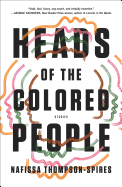
Nafissa Thompson-Spires's debut collection, Heads of the Colored People, is a kaleidoscopic illumination of often neglected aspects of contemporary middle-class black life. Her stories mix gallows humor and sensitive candor with issues of psychological and physical stress, marginalization and isolation. Like counterweights in conversation, her characters internalize, react to and resist the pressures of being black in the United States, negotiating "the violence directed inside [that] mitigates the violence that comes from outside."
"Heads of the Colored People: Four Fancy Sketches, Two Chalk Outlines, and No Apology," which won StoryQuarterly's 2016 Fiction Prize, destabilizes internal and external beliefs on what constitutes "blackness" while reiterating the vulnerability of all black bodies. In the painfully comic "Belles Lettres," two status-obsessed mothers whose daughters attend a predominately white school pass increasingly vicious notes to each other via their daughters' backpacks. In "The Body's Defenses Against Itself"--only one example of Thompson-Spires's flirtation with surreal body horror--the now-grown daughter of one of the mothers in "Belles Lettres" struggles to ground herself in a traumatized and teeming body. A woman teases her suicide on social media in "Suicide, Watch," a perfect showcasing of Thompson-Spires's brilliant use of the absurd both to emphasize and alleviate the pressure of difficult issues.
The stories in Heads of the Colored People float along the tensions between devastation and humor, vulnerability and defiance, frustration and hope. It's a rare talent that can take such complicated and harrowing subjects and turn them into a refreshing and compulsive read. --Shannon Hanks-Mackey, freelance editor and managing editor at the Black Scholar

